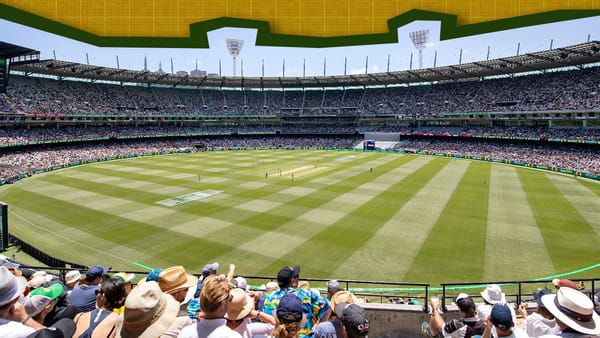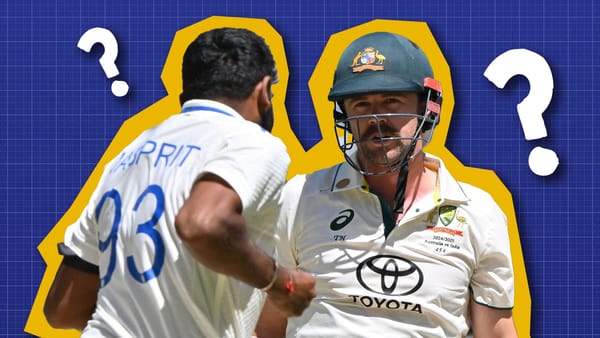Ross Taylor's long innings
Looking back at an extraordinary career.
Ross Taylor’s slog sweep is brutalist. It is not even always a sweep, as he doesn’t need to get down; it’s a standing hockey swat.
There was a time when Taylor was one of the best T20 batters on earth. It was only fleeting, but in 2008 he averaged 39 and struck at 182. That was across IPL, domestic T20s, and some internationals. At that stage he was playing this shot almost exclusively. If the ball was full, wide, or even straight, spin, seam, it didn’t matter; Taylor was in the position to play his stroke. His wagon wheels looked more like a compass, and his north was midwicket.
Other crazy guys have swept quicks, but Taylor isn’t even doing that. And he’s not using the pace of the seamers, as Mal Loye did. Taylor’s shot is forward of square, usually towards midwicket. And this is not even a cricket shot; it’s more of a drag-flick from hockey.
No player reached further to hit to leg. This is a man desperate to hit a shot, one shot, his shot. The single bloody-mindedness and the huge sixes are admirable.
It feels like the shot of an outsider, and that is what Taylor began as. It feels weird to say that about someone 16 years into his career.
But Ross Taylor came from rugby country inside a rugby country. The year he made his debut in first class cricket was when New Zealand domestic players went on strike.
Or as Iain O’Brien and others have suggested, you can’t actually be on strike from something that doesn’t pay you. Because of the actions of those players, New Zealand cricket was changed forever.
And Ross Taylor became the first thoroughly professional New Zealand player. That’s how he played, right, like a pro’s pro. Got on with the job, did what was needed, and was as dependable as they come.
But he started in a way that wasn’t anything like that. That stand up hockey slap is probably something that came from the days when Taylor was a slogger. Or, as Martin Crowe said, a dirty slogger.
It’s also worth noting where Crowe was coming from at that time. Crowe had written a column saying that Maori players - which Taylor is not, however he is Samoan - did not have the temperament for Test cricket. There is no doubt that Crowe had a racial issue here and that he possibly saw Taylor at first through that light.
But Crowe became Taylor’s mentor. And considering the type of players they both were, Taylor wouldn’t have been able to find a better fit to look after him. It’s also incredible to think of how similar their records came out as.

They obviously played in different eras and with separate pressures on them. But Crowe came from a cricketing family, and was a chosen player at an early age. Taylor was overcoming prejudices in New Zealand cricket and had to blaze his own path. To end up with a record like Crowe’s is extraordinary.
It’s also important to note that Crowe went from a heretic to a believer on Taylor. Crowe tweeted that he had burnt his blazer in protest when Taylor lost the captaincy. He didn’t do that, mostly because he wasn’t sure where his blazer was. But that’s how far Taylor moved Crowe.
And remember, Crowe was the best New Zealand batter of all time. That is literally what they said of him when the ICC put him in the hall of fame. He was weird, creative, flamboyant, downright bizarre, but you couldn’t watch him without being hooked. From working out how to play reverse swing through to changing ODI cricket by opening with a spinner. He was a first-tier legend.
And Taylor was on that path. Whether he was going to be better than Crowe was debatable, but it was clear he could be their best batter for modern New Zealand at the least. In 2012 he averaged 54 while making hundreds in India and Sri Lanka, in 2013 he averaged 72.

That was also the last year that Kane Williamson averaged under 45. It wasn’t that Taylor got any worse; it was just that Williamson was so much better. And so any chance of him being the next great batting hope was taken by the bloke standing at the other end.
And he did stand at the other end a lot. Taylor and Williamson have more than a thousand runs together than the next best partnership.

Taylor’s second-highest is with McCullum, and that’s less than 1500 runs.
Prince Brendon McCullum is the other person complicating Taylor’s legacy, what with the whole Coup thing.

Very few were harder on McCullum when he manoeuvred to get Taylor out than I was. It felt so cruel and savage. But history suggests that McCullum had perhaps the biggest influence on a national team of modern times. New Zealand went from a timid nation where their best players were disappearing to the IPL, into a team that has made the last three ICC finals. That transformation probably wouldn’t happen under Taylor.
If only because Taylor was a different kind of leader. But the team was splitting under him, and he was seemingly unable to bring them together, which certainly happened under McCullum.
So Taylor was on the road to being New Zealand’s best modern batter, and Williamson came along, and when he was captain and McCullum took that from him as well. Before Williamson eventually grabbed that job too.
But Taylor still was a remarkably talented player, capable at home and away. He made hundreds in England, India, Sri Lanka and a 290 in Australia.

This was a player whose skills travelled, even if he was clearly at his best when at home.
Peak Taylor was really from the start of 2012 until the end of 2017. And he was magnificent in that era, averaging over 50, and over Williamson. Pujara, De Villiers, Clarke, Kohli, Sangakkara, Chanderpaul and Smith were the players who averaged more.

Taylor is up there with the very best names in batting, and floating over 50 for six years is one hell of a magic trick.
But Taylor still had a good start to his career, it’s really only been since the global pace playing pandemic that he has struggled.

And that could also be age.
In ODI cricket he wasn’t a good player; he was an all-time great. He probably got good at a point where many people paid more attention to T20 cricket. And while he flirted with being a beast there, his heart never seemed quite in it. In ODIs, he’s just a straight-up legend. Of the players with 6000 runs, he has the 7th best average of all time.

His strike rate is slow, but still clear of Williamson’s. And part of that was his job in the team, it was for others to go hard, it was for him to bat long. And that is what he did, a lot.
Taylor is probably not at that level for Test cricket, but he’s undoubtedly an all-time New Zealand player. And the combination of those two things means he is a near-certain ICC hall of fame member. But he’s an automatic legend for New Zealand. He is currently the top run-scorer in Test cricket, with the fifth-best average. And ODI cricket he’s number one for average and runs scored.
His place in New Zealand history is assured.
As a batter I want to walk through one thing. Taylor had an eye test after struggling in a Test match in 2015 against Australia. He had a pterygium, which is a small benign growth.
Off to get my Pterygium removed 🙈😩😜
— Ross Taylor (@RossLTaylor) 1:02 AM ∙ Nov 30, 2016
A few days later Taylor made 290 after being told to simply open his eyes wider with some eye drops. Eventually, he would receive eye surgery. But, in the two years before that eye test, he had averaged 51 across all international cricket. In the two years after seeking help, he also averaged 51.

That is a batting master. To be able to do that with limited eyesight means that you are so much more than a dirty slogger with some lovely attacking shots, that means you are in rare air.
One thing I loved about Taylor was the combination of aggressiveness and fragility. He was about to pump you over deep mid-wicket, or carve you through point, but early in his innings, he had this nervous energy that made him feel like he could be out any ball. It made watching him nervewracking or exhilarating.
But he did one last thing I want to talk about. Ross Taylor hit the winning runs in the World Test Championship final. Think about where he came from. A boy from Rugby country who entered an amateur system became a professional who starred worldwide and ended up being the person who confirmed New Zealand as the first World Test Champs.
The innings that day wasn’t even a 50, but think about all the innings it took Ross Taylor to get there.
Episode 93 of Red Inker is @Vitu_E talking about the year in cricket
— Jarrod Kimber (@ajarrodkimber) 9:42 AM ∙ Jan 11, 2022




